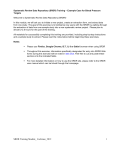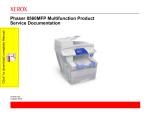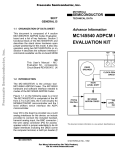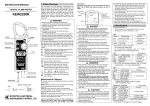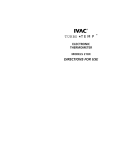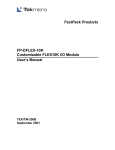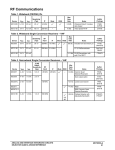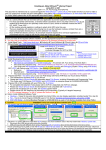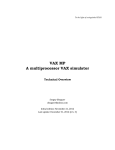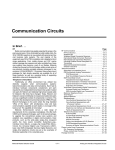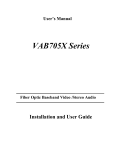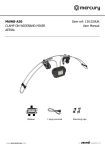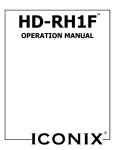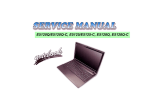Download AN2031 Interfacing the 68360 QUICC to T1/E1 Systems
Transcript
Freescale Semiconductor Order this document by AN2031 MC68360 Applications Information Freescale Semiconductor, Inc... Interfacing the 68360 (QUICC) to T1/E1 Systems By: Al Chame’, Technical Sales Engineer San Jose, CA Communications controllers are becoming increasingly sophisticated systems which are integrated on a single silicon chip. It is truly remarkable to witness the numerous functions and features supported by the silicon solution. The level of integration has provided the flexibility to transport different protocols, and to connect to and process multiple wide band communications channels emanating from potentially diverse interfaces. The introduction of the Freescale MC68360 communications controller offers system designers exceptional flexibility and control of communications systems. The MC68360 provides revolutionary control and flexibility to a system designer. It has become challenging for the system designer to harness the enormous capacity and functionality of such a device. This, combined with the freedom to interface to different systems such as PBXs, LANs, WANs, point-to-point links, Routers, Bridges, and digital public data networks such as the T1/E1 systems, adds to the complexity of the task. The diverse interface flexibility raises the importance of a thorough understanding of these interfaces and the power and sophistication of the resources available on the MC68360 controller. This document serves to introduce the numerous features offered on the MC68360 controller so the designer can effectively harness the available resources in serving different system interfaces. One interface which receives great interest because of its ubiquitous applications is the T1/E1 system and compatible formats. Compatible formats are: ISDN- both Primary and Basic rate, T1 DSU/CSUs, Digital Cross-Connect systems, customer premise multiplexers, bridge/routers, SMDS and other public data networks equipment. This article examines and illustrates various scenarios of interfacing the Freescale MC68360 controller to typical T1/E1 systems. Representative connections of T1/E1 serial data stream interfaces are illustrated to clarify its distinctive features. Applications ranging from the simplest interface to more complex and sophisticated interfaces are discussed. This will help one to better understand the MC68360 controller features and the interfaces it supports/implements. T1/E1 SYSTEMS INTERFACE METHODOLOGY Single or multiplexed high-speed T1/E1 lines are easily connected to the 68360 via the SI (serial interface). The SI permits connection of the MC68360's six serial channels (four SCCs and the two SMCs) to their own set of individual pins, or to TDM (time division multiplex) channels. Each SCC or SMC thus may be independently connected to the TDM or to its own external pins. The NMSI (Non-multiplex serial interface) and TSA (Time Slot Assigner) connection features of the SI make this setup possible. The NMSI allows the SCC/SMC to be connected to its own dedicated external individual pins. The decision to connect a given SCC to the NMSI is made in the SICR register of the 68360. Likewise, the decision to connect a given SMC to the NMSI is made © Freescale Semiconductor, Inc., 2004. All rights reserved. Freescale Semiconductor, Inc. in the SIMODE register. The TSA, on the other hand, allows programming any combination of SCCs and SMCs to multiplex their data on to one or two full duplex TDM channels which can be supported simultaneously. The TSA identifies a TDM channel using sync pulses and clock signals provided by the user, and implements the internal route selection. The TSA implements accordingly both the internal route selection and time-division multiplexing for multiplexed serial channels. The two TDMs interfaces must first be connected to the TSA for proper operations. To accomplish this, The TSA may be programmed as follows: 1.) Enable the TDM channels and select either: Static Frames (frames in which the routing is not changed frequently, and any TDM routing changes require all SCCs/SMCs connected to the TSA be disabled) or Dynamic Frames (TDM routing changes can be realized while the SCCs/SMCs are connected to the TSA) operation. Dynamic frames provide significant flexibility in dynamic system reconfiguration. Select this configuration by programming the SIGMR (SI Global Mode Register).(7.8.5.1) Freescale Semiconductor, Inc... 2.) Enable the clock routing to the SMC channels and synchronous/ asynchronous TDM operations by programming the SIMODE (SI mode register). (7.8.5.2) 3.) Enable the clock routing to the SCCs by programming the SICR ( SI clock route register). (7.8.5.3) In its most flexible mode, the TSA can provide two separate TDM channels, each with independent transmit and receive routings, and independent sync and clock inputs. Thus, the TSA can support two independent full-duplex or four independent half duplex TDMs, two for transmit and two for receive, each with their own independent sync and clock inputs. Additionally, the TSA will also support multiplexing data from channels / devices which do not form part of the SCCs or SMCs, by utilizing up to four special programmable Strobe signals that may be asserted on a bit basis or a byte basis. This provides extra flexibility in supporting devices which do not reside on-chip. Once the TSA connections are established, the exact routing decisions are made by initializing the TSA timeslot in the SI RAM. This requires two SI RAM entries: one used for the transmit routing and the other for the receive routing. The two SI RAMs entries provide the clocking assignment for each SCC/SMC, and connect the SCC/SMCs to the TSA. These SI RAMs locations are directly accessible by the host processor in the internal section of the QUICC and are not associated with the on-board dual-port RAM. It is to be noted that the TSA time-slot programming is completely independent of the protocol used either by the SCCs or the SMCs. The size of SI RAM available for time-slot programming is dependent on the nature of the time-slot programming used. The programming can be implemented for either Static or Dynamic Frames. There are four possible TSA RAM configurations specified below: 1.) One TDM multiplexed channel with Static Frames: 64 entries for the transmit routing and 64 for the receive routing. 2.) One TDM multiplexed channel with Dynamic Frames: 32 entries fortransmit and 32 for receive. 3.) Two TDM multiplexed channels with Static Frames: 32 entries for transmit and 32 for receive. 4.) Two TDM multiplexed channels with Dynamic Frames: 16 entries for transmit and 16 for receive. For proper operation, the SI RAM should be initialized before enabling the multiplexed channels. It is worthwhile to mention that the SI RAM also supports two testing modes, echo and loop-back mode. Echo retransmits the signal it has received and the loopback mode causes the physical interface to receive the same signal it is transmitting. 2 For More Information On This Product, Go to: www.freescale.com Freescale Semiconductor, Inc. What clock frequency/data rates can be used by the TSA? Freescale Semiconductor, Inc... The maximum TSA input clock rate depends on the SynCLK rate. SynCLK, which is generated in the QUICC clock synthesizer specifically to support the SCCs, SMCs, and the TSA, defaults to the system frequency (25 Mhz). However, the clock synthesizer in the SIM60 module can divide the SynCLK by 1, 4, 16 or 64 before it leaves the clock synthesizer. The user selects a clock compatible with the SCCs and SMCs which are connected to the TSA, as well as those connected to their own pins. The maximum external serial clock frequency input to the TSA is SynCLK/2.5 (i.e 10 Mhz clock for a 25 MHz 68360 system). This not only allows T1/E1 compatible clock frequencies and data streams, but also DS1C, DS2, and E2 data streams to be supported. Thus the QUICC may be connected to T1, T1C lines, CSU/DSUs, DCSs, T2 , T1G, E1, E2, ISDN basic and primary rate; cell switching interfaces with T1/E1 compatible formats such as MSDS, ATM; and demultiplexed DS3 lines and other clock compatible T1/E1 formats operating at data rates up to 10 Mhz. TYPICAL T1/E1 INTERFACES Channel Banks The most common interfaces in public data networks are the T1/E1 multiplexers and or channel banks which form the backbone of the T1/E1 systems. Table 1 describes the frequency/data rate for T1/E1 system channel banks which potentially may interface to the MC68360. System T1 T1C T1G T2 T3 T4 E1 E2 E3 Data Rate Mbps 1.544 3.152 6.443 6.312 44.736 274.176 2.048 8.448 34.368 No. of Voice Channels 24 48 96 96 672 4032 30 120 480 U.S. Digital Signal No. DS1 DS1C DS2 DS2 DS3 DS4 Table 1. Digital carrier systems or channel banks are widely used in public data networks and local central offices. The channel bank provides carrier conversion between voice channels and a T1 circuit. The D4 channel bank in North America is the most commonly used today and can accept up to 50 different signals. The higher multiplexing level inputs are not always derived from lower multiplexers. For example, one single analog television signal can be converted directly to a DS3 data stream (44.73 Mb/sec). Similarly, the DSx streams can carry a mixture of information from a variety of sources such as video, VF, and computer binary data. T1G is a T2 type system and is the newest of the T-carrier type systems. It uses standard 1 mile repeater spacing and standard exchange cable. Instead of binary levels, it uses M=4 (quaternary) multilevel signaling similar to the ISDN U quaternary coding, where +3V represents the two binary bits 11, +1V represents 01, -1V represents 00, and -3V represents 10. To achieve reliable signaling, the T1G equipment inserts additional parity and framing bits into the input stream DS2 (6.312 MBPS) signal so that a total bit rate of 6.443 Mbps is 3 For More Information On This Product, Go to: www.freescale.com Freescale Semiconductor, Inc. needed. Since T2 can not use standard exchange cables, it is not as popular as other T1systems. TIG is expected to be a popular replacement to T2. In addition, old T1C type systems can be upgraded to DS2 perfromance by replacing the old T1C repeaters with T1G repeaters. ADPCCM (Adaptive Differential Pulse Code Modulation) Freescale Semiconductor, Inc... With the implementation of the 32 Kbps Adaptive Differential Pulse Code Channel Modulation (ADPCCM), the T1 capacity of 24 channels can be increased to 44 channels on a single DS1 facility. In the United States, this is known as the M44 multiplexing interface specification and supports either a 12-frame superframe or the 24frame extended superframe format. The data stream is divided into 4 bundles, with each bundle consisting of 11 nibble (4-bits) voice channels and one additional nibble channel for signaling. Thus there will be 4 48-bit bundles and one additional bit for framing which totals 193 bit. SLC-96 & T1DM Carrier Systems and their Framing Formats. The SLC-96 is a digital subscriber carrier operating as a digital local loop with a proprietary framing format. The digital subscriber loop SLC-96 framing format is used between the Local Digital Switch (LDS) and the Remote Terminal. It supports a minimum of one T1 line and up to four T1 (96 channels). It essentially uses the D4 superframe format with specialized Data Link (DL) information bits. The system periodically uses the framing bits and replaces it with a low speed data link. The T1DM is used for Digital Data Service (DDS) among hub and local intermediate DDS offices and also uses the D4 superframe format. It uses a seven-bit channel for data, with bit 8 of each channel byte reserved for network use. Most T1 I.C. framers support both the SLC-96 and T1DM formats. Digital Cross-Connect (DCS): A digital cross-connect, also called Digital Access Cross-Connects (DACS), provides a connection between various T1 circuits. It allows T1 streams to be split into their individual voice channels and later recombined in a different grouping onto another T1 stream. Digital cross-connects come in a variety of forms and capacities that allow multiple channels of incoming T1 circuits to be integrated onto any desired combination of other T1 circuits for routing purposes. A DCS can be thought of as a nonblocking, time division digital switch that interconnects multiple synchronous bit streams. A DCS can be cross connected and put into any combination of composite T1 circuits. As digital cross connect equipment evolves, different terms are being used to describe the various input and output capabilities. A 1/1 DCS allow T1 channels on the input to be re-routed to other T1 channels on the output. A 3/1 DCS integrates T1 channels with T3, and a 3/3 DACs allows T3 channels to be intermixed with other T-3 channels. A DCS may also be used to route around circuits breaks. Multiplexers Point-to-Point Multiplexer: The standard point-to-point multiplexer supports a single active T1 link supplying access to each of the individual 24 channels at the user's own facility. Currently, as the carrier signals are routed through the network the multiplexing technique takes the rate from T1 to T1C, to T2, and then to T-3 at 44.736 Mbps 4 For More Information On This Product, Go to: www.freescale.com Freescale Semiconductor, Inc. (referred to as 45 Mbps service). When going up and down this hierarchy, there must be multiplexing from level to level and dummy, or stuffed, bits are inserted so that signals of different rates can be sent at higher rates with all the appropriate framing information maintained. Thus this type of multiplexing requires an overhead of stuffed bits for proper operation. At the receiving end, the bit stream must be demultiplexed to restore the original form and lower data rates. Fig. 1 depicts the T1 hierarchy. DIGITAL LEVELS DIGITAL FACILITIES DS4 (274.176 Mbit/s) (4032 channels) T4M,DR18 Freescale Semiconductor, Inc... M34 DS3 (44.736 Mbit/s) (672 channels) 1 MX3 DS2 (6.312 Mbit/s) (96 channels) 1 14 M1C 1 1 7 DS0 (64 Kbits) (24 Channels) Analog Channels Digital Channels 1 2 FT3,3ARDS DRG-30 M13 MX3 M12 2 3 4 1 26 T1C,T1D T1,T1/0S 1ARDS Channel bank Channel bank Channel bank 1 1 1 24 FT3,3ARDS DRG-30 MX3 DS1C (3.152 Mbit/s) (48 channels) DS1 (1.544 Mbit/s) (24 Channels) 6 24 24 Figure 1. Synchronous Transmission (SYNTRAN): SYNTRAN is a recently devised multiplexing mechanism which eliminates the overhead of stuffed bits. SYNTRAN, designed for operation up to 45 Mbps, allows efficient access to individual DS0 channels, as well as DS1 data streams, which in turn eliminates the need to go through the intermediate multiplex level of DS2. All signals entering the SYNTRAN device are multiplexed with a single master clock so their specific locations are known and they can be individually added to or dropped from the DS3 stream. 5 For More Information On This Product, Go to: www.freescale.com Freescale Semiconductor, Inc. Because SYNTRAN can only support DS3 and lower transmission rates, SONET (Synchronous Optical Network), with a basic transmission rate of 49.920 Mbps, was proposed as a solution for higher data rate applications. Drop and Insert Multiplexing: A second multiplexing method is known as drop and insert. The drop and insert multiplexer is utilized where the user needs to remove some DS0 channels, add others, and at the same time maintain T1 capacity between individual locations along a circuit path. The drop-and insert locations are normally geographically dispersed, so a substantial amount of network capacity can be incorporated into the system by utilizing the available DS0 channels that exist in each point-to-point connection. Freescale Semiconductor, Inc... Networking Multiplexer: A third type of multiplexer is called a networking multiplexer. This device allows several T1 circuits to be configured with a DCSs such that entire DS1 channels or DS0 channels may be switched at an individual user location. LAN data has become the most prevalent data traffic on T1 networks, reflecting a fundamental change in the nature of data networking. Years ago, network data consisted mainly of terminal-to-host traffic. Now, LANbased workstation-to-host traffic predominates, and in a few years, data traffic is predicted to be entirely LANto-LAN. PBX INTERFACES Computer to PBX Interface (CPI): CPI is a standardized 24 channel interface developed by Northern Telecom and DEC, and supported by ROLM, Mitel and Intecom. CPI uses 23 channels for data, and the 24th channel for signaling supervision. This format is compatible with both ISDN and AT&T's Digital Multiplexed Interface (DMI) which also reserves channel 24 for signaling. This type of separate channel signaling scheme is also compatible with existing common control interface signaling (CCIS). Both CPI and DMI describe the necessary protocol definitions to support data transport at all the standard transmission rates between the PBX and the user's front end equipment. CSU (Channel Service Unit)/DSU (Data Service Unit): The DSU converts DTE signals into bipolar digital signals and performs clocking and signal regeneration on the channel. The CSU performs functions such as line conditioning (equalization) which keeps the signal's performance consistent across the channel bandwidth, signal reshaping which reconstitutes the binary pulse stream, and loop-back testing which entails transmitting test signals between the CSU and and the network carrier's central office channel unit (OCU). T1 multiplexers must connect through a CSU or an equivalent device. 6 For More Information On This Product, Go to: www.freescale.com Freescale Semiconductor, Inc. Freescale Semiconductor, Inc... THE 68360 INTERFACING TO ONE TDM CHANNEL As a first design illustration, the simple case of the 68360 connected to a single TDM is examined. In this scenario, the data stream from the 68360's six serial channels are multiplexed onto a single synchronous DS1 data stream using one synchronous TDM enabled for dynamic frames. Synchronous TDM implies synchronous transmit and receive frames i.e. common sync and clock pulses for the transmit and receive frames. This is accomplished very simply by programming the CRTa,b bit in the SIMODE register. It is assumed the serial DS1 data stream emanates from a T1 source such as a T1 transceiver. In addition, four external devices which do not have a built-in time slot assigners, will multiplex their data onto the same 68360 TDM channel. Strobes generated by the 68360 enable these voice or "non-clear" channels. Data from the external devices and 68360 serial channels is combined and ultimately connected to the T1 transceiver. In this example, a T1 transceiver such as the 2180A made by Dallas Semiconductor and Crystal Semiconductor is used. The 2180A transceiver supports the 68360 serial channels with "clear" or data channels, and as most integrated T1 transceivers do, allows mixing "clear" and "non-clear" DSO channels, and the insertion of idle code on the same DS1 stream. The 2180A transceiver is programmed to operate either in the SF (superframe) or ESF (extended superframe) mode. This design scenario demonstrates the 68360's versatility in interfacing to several T1 compatible interfaces. The 2180A channel connections to the 68360 serial channels are as follows: 1.) SCC1 with 4 DS0 channels occupying time slots 1 thru 4. 2.) SCC2 with 1 DS0 channel occupying time slot 6. 3.) SCC3 with 6 DS0 channels occupying time slots 7 thru 12. 4.) SCC4 with 6 DS0 channels occupying time slot 13 thru 18. 5.) SMC1 with 1 DS0 channel occupying time slot 22. 6.) SMC2 with 1 DS0 channel occupying time slot 23. Note The configuration of 6 DS0 channels / 386 Khz bandwidth such as in the case of SCC3 and SCC4 above is typical of video codecs applications requirements and is also used extensively in ISDN as H0 channels. As mentioned above, the 68360 enables several external voice devices with its strobes (L1ST1, L1ST2 and L1ST3): one MC145540 ADPCM voice codec, one MC145532 ADPCM encoder/decoder, and two MC145480 PCM voice codecs. The MC145540 is a combined PCM codec-filter and an ADPCM encoder/decoder which permits digitization and compression of voice signals and operates off a single 5/3.3 V supply. The MC145532 is an ADPCM encoder/decoder and the MC145480 is a single 5V supply PCM codec-filter. The MC145532 and MC145480 both allow voice compression ratios from one up to four. It is useful to briefly elaborate on the operation of the external ADPCM and codec devices. These devices operate either with Short Frame or Long Frame Sync clocking. The term "Sync" refers to the function of synchronizing the PCM data word onto or off the multiplexed TDM channel. When interfacing to the 68360, the use of Long Frame Sync "clocking" provides greater flexibility to choose the desired ADPCM voice compression ratio. This setup is used in the discussed design example. Since this is a synchronous DS1 operation, the MC145532 uses one sync clock for both transmit and receive sections of the device i.e. the EOE, EIE, DOE and DIE control pins are tied together and controlled by a Long Frame Sync pulse strobe from the 68360. Similarly, both the FST transmit and FSR receive control signals of each MC145480 and the MC145540 are tied together, and driven by a single Long Frame Sync clock. If one TDM is programmed with dynamic frames, the initial current RAM addresses in the SI RAM are as follows: 7 For More Information On This Product, Go to: www.freescale.com Freescale Semiconductor, Inc. • 0-63 RXa Route • 128-191 TXa Route and the shadow RAMs are at addresses: • 64-127 RXa Route • 192-255 TXa Route Initialization Sequence of the 68360 1.) Programming the SI RAM 7.8.4.5. (7-77) Freescale Semiconductor, Inc... There will be 13 entries each for the receive and transmit SI RAM. Entry # 1 2 3 4 5 6 7 8 9 10 11 12 13 SWTR SSEL 1-4 14 15 13-10 0 0 0000 0 0 0000 0 0 0000 0 0 0000 0 0 0000 0 0 0001 0 0 0001 0 0 0010 0 0 0000 0 0 0011 0 0 0000 0 0 0000 0 0 0000 9 0 0 0 0 0 0 0 0 0 0 0 0 0 CSEL 8-6 001 000 010 011 100 111 111 111 000 111 101 110 000 CNT 5-2 0001 0000 0000 0101 0101 0011 0011 0011 0011 0000 0000 0000 0000 BYT LST 0 1 0 1 0 1 0 1 0 1 0 1 0 0 0 0 0 0 0 0 0 1 0 1 0 1 1 1 Description bits in SI RAM 4 bytes SCC1 1 byte skipped 1byte SCC2 6 bytes SCC3 6 bytes SCC4 4 bits MC145532 4 bits MC145480 4 bits MC145540 4 bits no support 1 byte MC145480 1 byte SMC1 1 byte SMC2 1 byte no support Table 2. Note: The above entries are made in the SI RAM receive section starting at entry 0 and continuing through entry 12. An identical entry is made in SI RAM transmit section entries 128 through 140 because one TDM with dynamic frames is used. Also, if a MC68360 strobe is configured to be asserted in two consecutive SI RAM entries, then it will remain continuously asserted during the processing of the SI RAM entries. 2.) Programming the TDM pins: TDMa is selected arbitrarily as the TDM channel, since only one TDM is used. Parallel I/O register programming. • The PAPAR (port A pin assignment register) register bits DD6,7 and8 are set to 1. The 2180A transceiver serial XMT and RCV signals are connected to TDMa L1TXDA and L1RXDA (PA6 & PA7), and RCLK (receive clock) of the 2180A is connected to L1RCLKA (PA8). 8 For More Information On This Product, Go to: www.freescale.com Freescale Semiconductor, Inc. • PADIR: Set DR7,8 to 0 (inputs) and DR6 to 1 (output). • PAODR : Set OD6 to 1. (Configures L1TXDA to an open drain output). • PCPAR: Set DD11 to 1. (connects RFSYNC of 2080A to L1RSYNCA). • PCDIR: Set DR11 to 0. (input) 3.) Other peripheral programming: • PBODR: Set OD12, OD13, and OD14 to 0. (Set L1ST1, L1ST2, and L1ST3 strobes for voice devices). Freescale Semiconductor, Inc... • PBDIR: Set OD12, OD13, and OD14 to 1. 4.) SICMR= $C0. (SI Command Register) Dynamically programs the SI RAM (only TDMa in the dynamic frame mode is used and therefore entry is $C0.) (7-89) 5.) SIGMR= $05. Enable the TDMa (32 entries each are available for transmit and receive routing, with similar entries for shadow RAM). (7-83) 6.) SIMODE= $8000814D. Programs the SIMODE register. This is explained as follows: (7-84) • SMC1,2 = 1,1 • SM1CS1,2 = 000,000 • SDMa,b = 00,00 ( Normal operation.) • RFSDa,b = 01,00 (One bit receive frame delay.) • DSCa,b = 0,0 (Channel clock is equal to the data clock.) • CRTa,b = 1,0 (Synchronous transmission- both transmit and receive frames use common sync and clock.) • STZa,b = 0,0 (Sets up L1TXDx.) • CE a,b = 0,0 (Data transmitted on the rising edge of the clock and received on the falling edge of the clock.) • FEa,b = 1,0 (Frame sync sampled on the rising edge of the clock.) • GMa,b = 1,0 (Grant mode mechanism supported.) • TFSDa,b = 01,00 (One bit transmit frame sync delay.) 7.) SICR = $40404040. 8.) Enable the 4 SCCs and the two SMCs for desired protocol operation. It is worthwhile to note that the data stream connected to the TDM may originate from many sources other than a DS1 source. Possibilities include a SLC-96 system, a DS2/T1G system with a 96 time slot/ 6 MHz capacity, an E2 multiplexer with an 8 Mhz bandwidth , a DS3 demultiplexer, or any multi T1/E1 wide band-source such as an inverse multiplexer. It is also significant to highlight use of the 68360's SPI bus as a control interface to other devices. The 68360 SPI bus allows the T1 transceiver to be initialized and configured for different applications. The following modes can be programmed: "clear" and "non-clear" channels, zero suppression modes, superframe or extended superframe modes, SLC-96 or T1DM applications, and DS3 framers/ formatters. Further, the 68360 SPI bus programs the different desired voice "compression ratios" of the ADPCM codecs and allows significant flexibility in system operation. 9 For More Information On This Product, Go to: www.freescale.com Freescale Semiconductor, Inc. ASYNCHRONOUS TDM APPLICATIONS Some applications require asynchronous TDM operation which is the most generic operation mode. This is accomplished very simply by programming the CRTa,b bit in the SIMODE register. In addition, the user supplies four inputs to the TDM as opposed to two in the synchronous mode. These inputs consist of two sync signals, L1TSYNCA and L1RSYNCA, and two clock signals L1TCLKA and L1RCLKA. The connections are programmed in parallel port A and C. Typical asynchronous applications include D4 channel banks and similar equipment. Freescale Semiconductor, Inc... TDM AND NMSI OPERATIONS A variation of the above application requires a combination of serial channels connected to the TDM and one or more serial channels each connected in NMSI mode. It is common to encounter an application where a T1 framer, as described above, connects to the 68360 serial channels in the following manner: One serial channel (e.g. SCC2) operates in the NMSI mode, and the remaining serial channels connect to the TSA (TDMa). The 68360 SCC2 communicates with the 2180A/B, or any similar framer, on the Facility Data Link (FDL) for both scheduled Performance Messages (PRMs) and unscheduled messages. The FDL is a 4 KHz data link extracted from the framing bits of all odd DS1 frames to provide performance monitoring data, control and maintenance, and perform loopback commands on the T1 transceiver. FDL is a powerful resource and used in many applications such as CSUs and network management tools. FDL also allows carrying other virtual circuits to control video codecs, channel banks , bridge /routers and other equipment. Most communications on the FDL link use the HDLC/LAPD protocol and therefore utilizing an SCC for this function is appropriate. The entries in the SI RAM receive and transmit section detailed above have to be modified accordingly to support this configuration by deleting entries for SCC2. SCC2 connections to the 2080A/B are shown in Fig. 2 and are implemented as follows: • RXD2 (PA2) connected to RLINK. • TXD2 (PA3) connected to TLINK. • CLK2 (PA9) connected to TLCLK. 10 For More Information On This Product, Go to: www.freescale.com Freescale Semiconductor, Inc. R0+ R0- DT DR EDI DDO BCLKT • BCLKR • MCLK FST • FSR • • • DDC EDC • EIE DIE • • • • BCLKR BCLKT TSER RSER RFSYNC • T1+ T1PO+ PO- DT DR FST FSR • CS SDI SDO SCLK SCPTx SCRx SCCLK SCXX • To SPI Bus SPI Bus to Master/Slave Devices FST FSR • • MC145480 3 RxD2 CLK2 TxD2 BCLKT BCLKR MCLK DT DR L1RxDA L1RCLKA L1TxDA L1RSYNCA • • 4 RCLK MC145540 T1+ T1RO+ RO- To SPI Bus • • L1ST1/2/3 Freescale Semiconductor, Inc... • EDO DDI 2180 A/B T1 XCVR RLCLK RLLINK TLCLK TLLINK T1+ T1- MC145532 SPISEL SPICLK SPIMISO SPIMOSI I/0 MC145480 MC68360 Figure 2. A typical application for the above mentioned configuration is a T1 CSU which extends from the customer premises to the carrier's local office where it usually terminates on DCS 1/0. Since FDL also terminates on DCS and thus does not provide end-to-end communications and control, it is important to the central office carrier to have a communications link to control the customer-premise equipment through the CSU. The MC68360, as an integral part of a CSU and/or part of a bridge/router, can easily implement this link. It is important to highlight that in the same system, the MC68360 may also support a LAN and perform bridge/ router functions. Fig. 3 illustrates such a scheme where a Central Office is controlling a CPE T1 CSU. 11 For More Information On This Product, Go to: www.freescale.com Freescale Semiconductor, Inc. CENTRAL OFFICE DCS 1/0 COMMUNICATIN/CONTROLLING CPE CSU VIA FDL CPE T1 CSU and/or Bridge/Router Local Central Office T1 1.544 Mbps Data Stream TDM Freescale Semiconductor, Inc... I/O Digital Cross Connect FDL Virtual Circuits FDL TSA SCC2 (NMSI) SCC1 To LAN (NMSI) (Ethernet, Token Ring, etc or Bridge/Router, Video Codec) MC68360 Central Office Management System Figure 3. An equally important application involves the termination of a Fractional T1 (FT1) on a customer premise. Again, an FT1 normally terminates on a DCS 1/0 at the local center office which grooms and routes the FT1 circuits. Since FDL terminates at the DCS1/0 demarcation interface, it can not be used for end-to-end FT1 control messages. However, recent standards (Annex B of T1E1.2-003R3) now demand that part of the FT1 bandwidth carry monitoring data, commands and responses. FT1 CSU devices now should conform to this standard by carrying / responding to FDL data. This requirement can be met simply and cost effectively with a MC68360 as shown in Fig. 4. FT1 CSU CONTROLLED FROM LOCAL CENTRAL OFFICE Local Central Office I/O Digital Cross Connect FT1 CSU and/or Bridge/Router FT1 Data Stream TDM FDL Virtual Circuits FDL TSA SCC2 (NMSI) SCC1 (NMSI) MC68360 Figure 4. 12 For More Information On This Product, Go to: www.freescale.com To LAN, Bridge/Router, or other Devices Freescale Semiconductor, Inc. NMSI channels may be connected to wide-band channels which typically do not greatly exceed 2 MHz bandwidth. Examples are T1/E1 lines and HDSL (High bit-rate Digital Subscriber Line) transceivers connected directly, or indirectly through a T1 formatter. Fig. 5 represents a typical HDSL interface to the MC68360 through an HDSL transceiver. Here the T1 formatter forms part of the HDSL transceiver. INTERFACING TO HDSL & PBX Freescale Semiconductor, Inc... Customer Premise Equipment PBX Local Central Office HDSL XCVR DSI Data Rate TDM TSA SCC2 (NMSI) MC68360 2 x 784 Kbps HDSL Figure 5. The MC68360 also supports public cell switching services that extend LAN-type performance to the public network such as Switched Multi-megabit Data Service (SMDS) and Asynchronous transfer mode (ATM). Bellcore specifications require that SMDS physical layer (SIP Level 1) be DS1/DS3 compatible and normally emanate from ports on DCS, also referred to as DSX-1 and DSX-3. Fig. 6 illustrates how the MC68360 supports an SMDS data stream originating from a local SMDS Control & Reassembly Formatter (SCARF) such as a Brooktree Bt8210 or Bt8209. Fig. 7 shows a slightly different scenario in which the SMDS data stream emanates from a DCS 1/1 from the Local Central Office. 13 For More Information On This Product, Go to: www.freescale.com Freescale Semiconductor, Inc. MC68360 SUPPORTING TDM & SMDS CONNECTIONS SMDS Control & Reassembly Formatter SCARF T1 FRAMER SIP LEVEL 1,2 & 3 DS2141 SMDS (DSI Data Stream) SCC (NMSI) Freescale Semiconductor, Inc... BT8210 or BT8209 PBX, MUX, or T1/E1 XCVR TDM TSA MC68360 Figure 6. MC68360 SUPPORTING SMDS & TDM DATA STREAMS SET CUSTOMER PREMISE EQUIPMENT LOCAL CENTRAL OFFICE Switching System Exchange Termination DCS 1/1 DS1,E1 SMDS Data Stream SCC (NMSI) SNI Subscriber Network Interface DCS 1/0 T1 Data Stream TDM TSA MC68360 Figure 7. 14 For More Information On This Product, Go to: www.freescale.com Freescale Semiconductor, Inc. The simple scenario described above of interfacing to one TDM and/or NMSI channels is typical of and compatible with: 1.) Standard T1/E1 line interface and/or T1/E1 framers. 2.) An ISDN primary rate line which requires synchronous operation as described in the above synchronous TDM example. One SCC will be designated to perform the D channel function and is enabled for the HDLC protocol. 3.) Interfacing to Digital Cross Connect (DCS 1/0 or 3/1). 4.) Fractional T1 (FT1) or fractional E1. 5.) HDSL transceivers connected via a T1 framer. 6.) SLC-96 system which may consist of up to 96 channels. Freescale Semiconductor, Inc... 7.) T1DM systems. 8.) T1/E1 Channel Banks. 9.) Computer to PBX interface (CPI) and Digital Multiplex Interfaces(DMI). 10.)ADPCM M44 Multiplexing systems interfaces. 11.)A DS2/E2 framer signal or an inverse multiplexer with a wide bandwidth (8 Mhz). 12.)The 68360 as an integral part of a T1 DSU/CSU. DSU/CSUs are widely found as part of Customer Premise Equipment (CPE) or in local central offices performing many system monitoring and control functions. Most networks these days include CSUs performing network management functions and supporting proprietary protocols. 13.)Connection to SMDS data streams at the DS1/E1 demarcation levels or demultiplexed DS3 data streams. The above examples clearly illustrate the 68360's flexibility to support a wide number of system and circuit interfaces at the same time. THE 68360 INTERFACING TO TWO TDMs In this more complex scenario, the 68360 interfaces with a T1 framer transporting an ISDN primary rate data stream, and an ISDN U transceiver carrying an ISDN basic rate data stream. The 68360 serial channels multiplex their output onto two TDMs enabled for dynamic frames. A T1 transceiver, such as 2180A/B or the Dallas DS2141, connects to TDMa, and a U transceiver such as the Freescale MC145572 connects to TDMb. SCC1 supports the primary rate ISDN D channel (channel 24) while the SCC2 supports the basic rate D channel. The ISDN compatible data streams require that each TDM be synchronous and thus their respective routings are the same for the transmit and receive frames. It is relevant to detail the planning of system connections. The MC145572 U transceiver is a versatile device with an on-board time slot assigner which permits independent slot assignments of the D and two B channels. In this implementation of a wide-band 128 kbps modem (channel) controlled by SCC3, the B channels are given consecutive time slots (1&2) to simplify SI RAM programming. However, the MC68360 SCC serial channels are versatile in supporting non-consecutive time slots and can support the same bandwidth in this configuration. The D channel (time slot 4) is supported by SCC4. These channels are connected to TDMb. The versatility of the MC145572 and TDMb dynamic frames provide significant system flexibility for dynamic allocation of channel locations and resources. The T1 transceiver connections (thru TDMa) are as follows: SCC2 supports 16 DSOs in time slots 1 thru 16, with D channel in time slot 24. 15 For More Information On This Product, Go to: www.freescale.com Freescale Semiconductor, Inc. Two TDMs are configured with dynamic frames with the initial current-route RAM addresses in the SI RAM as follows: • 0-31 RXa Route • 64-95 RXb Route • 128-159 TXa Route • 192-223 TXb Route Freescale Semiconductor, Inc... and the shadow RAM addresses: • 32-63 RXa Route • 96-127 RXb Route • 160-191 TXa Route • 224-255 TXb Route Initialization Sequence of the 68360 1.) Program the SI RAM. Take care to initialize the Shadow RAM correctly as two TDMs are configured with dynamic frames. Entry # 0 1 2 64 65 128 129 130 192 193 SWTR 0 0 0 0 0 0 0 0 0 0 SSEL 0000 0000 0000 0000 0000 0000 0000 0000 0000 0000 CSEL 010 000 001 011 100 010 000 001 011 100 CNT BYT LST Description 0 16 bytes SCC2 RCV TDMa 1 1111 0 7 bytes skipped TDMa 1 0110 0 1 byte SCC1 RCV TDMa 1 0000 0 2 bytes SCC3 RCV TDMb 1 0001 0 1 byte SCC4 RCV TDMb 1 0000 0 16 bytes SCC2 XMT TDMa 1 1111 0 7 bytes skipped TDMa 1 0110 0 1 byte SCC1 XMT TDMa 1 0000 0 2 bytes SCC3 XMT TDMb 1 0000 0 1 byte SCC4 XMT TDMb 1 0000 Table 3. 2.) Program the I/O registers: • PAODR: Set bits OD4 & OD6 to 1. Configures L1TXDB and L1TXDA to open drain output. • PAPAR: Set DD4 ,5,6,7,8 & 13 to 1. Configures L1TXDA, L1RXDA, L1TXDB, L1RXDB, L1RCKLB. • PADIR: Set DR5, 7, 8 & 13 to 0, and DR4 & 6 to 1. • PCPAR: Set DD9 & 11 to 1. Configures L1RSYNCA and L1RSYNCB. • PCDIR: Set DR9 & 11 to 0, (inputs). 16 For More Information On This Product, Go to: www.freescale.com L1RCKLA & Freescale Semiconductor, Inc. • SIGMR = $0F. Enables TDMa & TDMb with dynamic channel routing. • SICMR = $F0. Enables Shadow RAM for XMT & RCV. • SIMODE = $010D010D • SICR = $C0C0C0C0 Note The ISDN transmitter grant mechanism is enabled to all SCCs which provides flexibility to dynamically change channel routings. Freescale Semiconductor, Inc... • Enable SCC1 and SCC4 for HDLC protocol to support D channels. In the above design example, the 68360 provides support to both ISDN Primary and Basic rate interfaces with the added flexibility to dynamically change channel routings and bandwidth. It is important to highlight two issues: 1.) The two TDMs may operate synchronously with each other i.e. share sync and clock signals. This frees one sync and one clock signal to be utilized as general I/O pins. Synchronous TDMs are commonly found in channel banks, multiplexers, inverse multiplexers, and Digital Cross Connects. 2.) The Dynamic frame configuration adds great flexibility to operations supported by this mode. Static frames may also be used for this operation mode. ASYNCHRONOUS TDM OPERATION The most nonexclusive applications require asynchronous operation of both TDMs. Program the appropriate CRTa,b pins in the SIMODE register to establish this operation mode. The user supplies four sync signal and four clock signal inputs to the TSA (TDMa,b). The required sync signals are L1TSYNCA, L1RSYNCA, L1TSYNCB, and L1RSYNCB, and the necessary clock signals are L1TCLKA, L1RCLKA, L1TCLKB and L1RCLKB. The MC68360 TDMs have the unique ability to transmit serially on one TDM and receive serially on a different TDM. This in effect implements a Digital Cross Connect system (DCS 1/0 or 1/1 ) since the maximum frame length supported by the 68360 varies from 2048 bits to 8192 bits i.e 256 to 1,000 time slots (depending on static or dynamic frame configuration). Thus the 68360 adequately supports channel switching from any wideband signal source such as inverse multiplexers, Syntran devices, T1G / E2, or DS3 demultiplexed signals, on each TDM. This allows inexpensive Switched T1 deployment which permits many new applications and services. Today there is significant demand for video intensive applications such as video conferences, center-to-classroom transmission, and telemedicine. The MC68360 readily supports the growing list of such applications. Recognize also that the 68360's strobe signals can control many other devices external to the chip and multiplex their signals onto the TDM channels. 17 For More Information On This Product, Go to: www.freescale.com Freescale Semiconductor, Inc. CONCLUSION Several MC68360 to T1/E1 digital data public equipment interfaces were discussed above to illustrate and highlight the MC68360 versatility and interface ease to many complex T1/E1 systems. REFERENCES MC68360 (Quad Integrated Communications Controller) User’s Manual, MC68360UM/AD Freescale Semiconductor, Inc... How to Reach Us: Home Page: www.freescale.com E-mail: [email protected] USA/Europe or Locations Not Listed: Freescale Semiconductor Technical Information Center, CH370 1300 N. Alma School Road Chandler, Arizona 85224 +1-800-521-6274 or +1-480-768-2130 [email protected] Europe, Middle East, and Africa: Freescale Halbleiter Deutschland GmbH Technical Information Center Schatzbogen 7 81829 Muenchen, Germany +44 1296 380 456 (English) +46 8 52200080 (English) +49 89 92103 559 (German) +33 1 69 35 48 48 (French) [email protected] Japan: Freescale Semiconductor Japan Ltd. Headquarters ARCO Tower 15F 1-8-1, Shimo-Meguro, Meguro-ku, Tokyo 153-0064 Japan 0120 191014 or +81 3 5437 9125 [email protected] Asia/Pacific: Freescale Semiconductor Hong Kong Ltd. Technical Information Center 2 Dai King Street Tai Po Industrial Estate Tai Po, N.T., Hong Kong +800 2666 8080 [email protected] For Literature Requests Only: Freescale Semiconductor Literature Distribution Center P.O. Box 5405 Denver, Colorado 80217 1-800-441-2447 or 303-675-2140 Fax: 303-675-2150 [email protected] Information in this document is provided solely to enable system and software implementers to use Freescale Semiconductor products. There are no express or implied copyright licenses granted hereunder to design or fabricate any integrated circuits or integrated circuits based on the information in this document. Freescale Semiconductor reserves the right to make changes without further notice to any products herein. Freescale Semiconductor makes no warranty, representation or guarantee regarding the suitability of its products for any particular purpose, nor does Freescale Semiconductor assume any liability arising out of the application or use of any product or circuit, and specifically disclaims any and all liability, including without limitation consequential or incidental damages. “Typical” parameters which may be provided in Freescale Semiconductor data sheets and/or specifications can and do vary in different applications and actual performance may vary over time. All operating parameters, including “Typicals” must be validated for each customer application by customer’s technical experts. Freescale Semiconductor does not convey any license under its patent rights nor the rights of others. Freescale Semiconductor products are not designed, intended, or authorized for use as components in systems intended for surgical implant into the body, or other applications intended to support or sustain life, or for any other application in which the failure of the Freescale Semiconductor product could create a situation where personal injury or death may occur. Should Buyer purchase or use Freescale Semiconductor products for any such unintended or unauthorized application, Buyer shall indemnify and hold Freescale Semiconductor and its officers, employees, subsidiaries, affiliates, and distributors harmless against all claims, costs, damages, and expenses, and reasonable attorney fees arising out of, directly or indirectly, any claim of personal injury or death associated with such unintended or unauthorized use, even if such claim alleges that Freescale Semiconductor was negligent regarding the design or manufacture of the part.



















